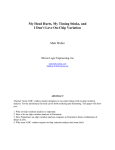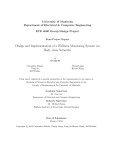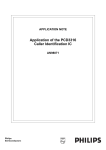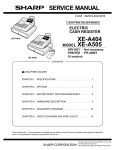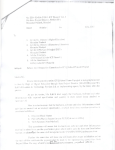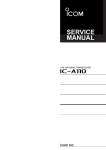Download AN96103 X-tal oscillators on 8
Transcript
APPLICATION NOTE X-tal oscillators on 8-bit microcontrollers AN96103 Philips Semiconductors X-tal oscillators on 8-bit microcontrollers Application Note AN96103 Abstract <Almost since the introduction of microcontrollers as electronic components there always has been an oscillator circuit on the device to make it work. From application point of view only some external components were required to make it work. However, to make sure that it will always work required more effort. This report is based on feedback from the market from customers applying 8-bit mircrocontrollers.> Philips Electronics N.V. 1996 All rights are reserved. Reproduction in whole or in part is prohibited without the prior written consent of the copyright owner. The information presented in this document does not form part of any quotation or contract, is believed to be accurate and reliable and may be changed without notice. No liability will be accepted by the publisher for any consequence of its use. Publication thereof does not convey nor imply any license under patent- or other industrial or intellectual property rights. 2 Philips Semiconductors X-tal oscillators on 8-bit microcontrollers APPLICATION NOTE X-tal oscillators on 8-bit microcontrollers AN96103 Author(s): Andre Pauptit Systems Laboratory Eindhoven, The Netherlands & Erik Nordberg Telecom Products Group Zuerich Keywords <80C51,P83CLxxx,P33xx,P84Cxxx,X-tal,Oscillator> Date: 20 september, 1996 (draft) 3 Application Note AN96103 Philips Semiconductors X-tal oscillators on 8-bit microcontrollers Application Note AN96103 Summary Designing-in 8-bit microcontrollers occasionally raises questions regarding the crystal oscillator circuit. The support groups in Eindhoven and Zuerich have gained some experience in responding to these kind of customer questions. This report reflects some of this experience. For engineers in the field as well as development engineers involved in microcontroller based products that do not have specific oscillator knowledge, reading this report may result in some awareness of the oscillator issues making it easier to approach questions on this subject. 4 Philips Semiconductors X-tal oscillators on 8-bit microcontrollers Application Note AN96103 Contents: 1. What this note IS and what it is NOT. . . . . . . . . . . . . . . . . . . . . . . . . . . . . . . . . . . . 7 2. The oscillator stage.. . . . . . . . . . . . . . . . . . . . . . . . . . . . . . . . . . . . . . . . . . . . . 7 2.1 Transconductance. . . . . . . . . . . . . . . . . . . . . . . . . . . . . . . . . . . . . . . . . . . 7 2.2 The Pierce oscillator. . . . . . . . . . . . . . . . . . . . . . . . . . . . . . . . . . . . . . . . . . 8 3. The external components. . . . . . . . . . . . . . . . . . . . . . . . . . . . . . . . . . . . . . . . . . 9 4. Oscillation condition. . . . . . . . . . . . . . . . . . . . . . . . . . . . . . . . . . . . . . . . . . . . . 9 5. The drive level issue. . . . . . . . . . . . . . . . . . . . . . . . . . . . . . . . . . . . . . . . . . . . 10 6. Oscillator circuits in practice. 6.1 Reducing amplitude . . 6.2 DC-offsets . . . . . . . 6.3 Driving other circuitry . . 7. Emulation and the X-tal oscillator. . . . . . . . . . . . . . . . . . . . . . . . . . . . . . . . . . . . . 15 7.1 PDS-51 approach. . . . . . . . . . . . . . . . . . . . . . . . . . . . . . . . . . . . . . . . . . 15 7.2 DS-750 /EB-51 approach. . . . . . . . . . . . . . . . . . . . . . . . . . . . . . . . . . . . . . 15 8. Ceramic resonators . . . . . . . . . . . . . . . . . . . . . . . . . . . . . . . . . . . . . . . . . . . . 16 8.1 muRata CSA Ceramic resonators. . . . . . . . . . . . . . . . . . . . . . . . . . . . . . . . . . 16 8.2 muRata CSU Ceramic resonators. . . . . . . . . . . . . . . . . . . . . . . . . . . . . . . . . . 17 9. Developments and future. 9.1 CCO . . . . . . . . 9.2 Low drive level. . . . 9.3 ACO . . . . . . . . . . . . . . . . . . . . . . . . . . . . . . . . . . . . . . . . . . . . . . . . . . . . . . . . . . . . . . . . . . . . . . . . . . . . . . . . . . . . . . . . . . . . . . . . . . . . . . . . . . . . . . . . . . . . . . . . . . . . . . . . . . . . . . . . . . . . . . . . . . . . . . . . . . . . . . . . . . . . . . . . . . . . . . . . . . . . . . . . . . . . . . . . . . . . . . . . . . . . . . . . . . . . . . . . . . . . . . . . 11 11 11 13 . . . . . . . . . . . . . . . . . . . . . . . . . . . . . . . . . . . . . . . . . . . . . . . . . . . . . . . . . . . . . . . . . . . . . . . . . . . . . . . . . . . . . . . . . . . . . . . . 18 18 18 18 10. Oscillators on the low-voltage microcontroller families. . 10.1 Oscillator circuitry . . . . . . . . . . . . . . . . . . . 10.2 Considerations for oscillation. . . . . . . . . . . . . 10.3 Example . . . . . . . . . . . . . . . . . . . . . . . 10.4 Recommended resonators . . . . . . . . . . . . . . . . . . . . . . . . . . . . . . . . . . . . . . . . . . . . . . . . . . . . . . . . . . . . . . . . . . . . . . . . . . . . . . . . . . . . . . . . . . . . . . . . . . . . . . . . . . . . . . . . . . . . . . . . . . . . . . . . . 19 19 20 22 23 11. Related circuits with an X-tal oscillator. . . . . . . . . . . . . . . . . . . . . . . . . . . . . . . . . . 24 11.1 using the PCF8583 RTC. . . . . . . . . . . . . . . . . . . . . . . . . . . . . . . . . . . . . . . 24 11.2 A few questions and answers on PCF8583 RTC. . . . . . . . . . . . . . . . . . . . . . . . . . 24 12. References . . . . . . . . . . . . . . . . . . . . . . . . . . . . . . . . . . . . . . . . . . . . . . . . . 25 5 Philips Semiconductors X-tal oscillators on 8-bit microcontrollers 6 Application Note AN96103 Philips Semiconductors X-tal oscillators on 8-bit microcontrollers 1. Application Note AN96103 What this note IS and what it is NOT. In the early days of electronics it was quite a challenge to design a circuit that did NOT oscillate. All kinds of unfor-seen component characteristics were the main reason for this, as well as limited knowledge of the oscillation phenomena. Electronics have come a long way since those days and today components characteristics are well defined. Oscillation has become a science and integrating oscillators even more. On the subject of oscillation and of integration of crystal (X-tal)* oscillators there are many scientific publications and courses that provide high level knowledge on this subject. This report will NOT repeat that. In many digital circuits, oscillator circuits are also integrated on the same chip just to provide the clock signal for the digital electronics. Usually only the active parts of the oscillator part is embedded and not the passive frequency determining parts. These parts are usually traditional components supplied by other manufacturers. This situation is also valid for most currently supplied microcontrollers. “How to assure oscillation?” = a very legal question from the application point of view. This report IS based on application feedback from the field, providing some background and practical knowledge to come closer to the ultimate answer to this question. *(A crystal or quartz in a circuit diagram is very often indicated as X-tal.) 2. The oscillator stage. Most microcontroller devices have an oscillator circuit (Xtal1,Xtal2) that will oscillate with an external crystal and external capacitors. The oscillator stage is basically an inverter type gate consisting of a N-channel and a PVdd Rbias Xtal2 Xtal1 Figure 1. Vss channel transistor. The main difference with a digital inverter stage is an integrated bias resistor (also called: feedback resistor) connected between output and input. This (semiconductor-) resistor feeds back the output voltage to the input which will balance (bias) the stage in its analog working area. In the quiescent situation this will generate a DC- input and output level of about 1/2 Vdd for CMOS devices (For TTL compatible versions it is just a little less). 2.1 Transconductance. When this oscillator stage is driven with an input voltage variation then this will result in an output current variation through an external load. This relation (dVi/dIo) is defined as the transconductance of the oscillator stage. 7 Philips Semiconductors X-tal oscillators on 8-bit microcontrollers Application Note AN96103 This tranconductance, indicated with “gm” is defined as the amount of current change as a result of the input voltage change. The unit is A/Volt or S (S=Siemens). Figure 2. Rbias Vi ~ Io Vss 2.2 The Pierce oscillator. The standard circuit for the oscillator is given in figure 3. A Crystal is connected between the output (Xtal2) and the input (Xtal1). Output and input have a capacitor connected to the ground. This is basically a Pierce oscillator circuit. With a proper dimensioning of the external components the circuit should generate an (almost) sine wave shape signal on the Xtal2 output pin. One of the parameters related to the oscillator stage that affects the oscillation is the transconductance. A certain value of gm is needed to assure start-up. During power-on a noise signal or a transient should result in an amount of energy fed in to the X-tal to make it start and resonate.This is one of the basic requirements for any oscillator stage. microcontroller Vdd Xtal1 Xtal2 Vss X-tal C1 C2 Figure 3. 8 Philips Semiconductors X-tal oscillators on 8-bit microcontrollers 3. Application Note AN96103 The external components. The frequency determining element in the external components is the crystal (X-tal). Basically a crystal behaves as an LC-circuit for serial resonance. Figure 4. shows a commonly used equivalent circuit. The resonant frequency is determined by the value of L and C, so this is series resonance. C0 represents the total parallel capacitance of the crystal and its value is usually much higher then the one of C. However its influence on the resonating frequency is very small. Some typical values for these equivalent components based on a 10 MHz crystal are: L = 0.01 H, C = 0.026 pF, Rx = 10 ohms, Co = 8.5 pF. X-tal L === Co C Rx Figure 4. Note that in an application the total equivalent value of Co is also highly influenced by the two external capacitors in the basic Pierce oscillator circuit figure 3. In fact the two capacitors in series shunt the crystal, meaning the Co is in fact increased. 4. Oscillation condition. An oscillator stage and external components are supposed the generate the clock signal. Is just connecting the external components to the oscillator stage the only condition for oscillation? Again, there are theories on the oscillation condition and the Barkhausen rule covers the oscillation condition basics. In a practical situation however there are many circuit parameters that will determine whether an oscillator circuit will show reliable oscillation.Here are just some of them: - Vdd, supply voltage. - fosc, oscillator frequency. - gm, oscillator stage transconductance. - Rx, equivalent resistor value. - C0, equivalent total parallel capacity. - Closed loop gain. Only for the crystal there are more then ten parameters. For a practical evaluation it is almost impossible to include all of them. A second reason for this is that many parameter values are not known to those engineers applying the component. Does this mean that oscillation will be a matter of luck? 9 Philips Semiconductors X-tal oscillators on 8-bit microcontrollers Application Note AN96103 Without going in much theoretical detail the impedance approach can be used to give an indication on the expected oscillation. The idea behind it is that the effective transconductance (1/ohm) should at least make up for the load (ohm) Figure 5. shows a characteristic that indicates a relation between the Rx,C0 and oscillation. When the coordinates of Rx and C0 are in the upper area, oscillation conditions are not met. When the coordinates cross at the characteristic or are in the lower area there will be proper oscillation. Now the difficulty arises in putting actual values on the Rx and C0 axis, as well as determining the right shape and position of the characteristic. Practical experience however indicates that a circuit like in figure 3: with C1= C2 = 30 pF will be in the safe area, when C0 is about 10 pF and Rx is about 100 ohm or smaller. A lower value of Rx allows a higher value of C0 and visa versa. ohm No oscillation area Rx Oscillation area C0 pF Figure 5. 5. The drive level issue. Once we have oscillation is there something else to worry about? Most of the information so far is based on experience with the standard 5 Volt microcontrollers. Their oscillator stage was designed to drive a crystal with about 1 mW. This means that the crystal itself should be specified to perform proper resonation when it is driven at this power level. This crystal parameter is called the drive level and it is specified with the crystal parameters. 10 Philips Semiconductors X-tal oscillators on 8-bit microcontrollers 6. Application Note AN96103 Oscillator circuits in practice. All the 5V microcontrollers have a Pierce oscillator circuit (Xtal1,Xtal2) that will oscillate with an external X-tal and two capacitors. This standard circuit is presented in most data sheets. In some cases there may be good reasons to modify the standard circuit e.g. to reduce interference and/or to compensate external influences. 6.1 Reducing amplitude Reducing the oscillator amplitude is a frequently used approach for e.g. reducing interference. The circuit (figure 5) is based on the “Recommendations to reduce the interference of 558 oscillator” (see References). This circuit generates an (almost) sine wave shape signal on the Xtal2 pin.This is achieved by using asymmetrical capacitors, and using the largest capacitor on the INPUT, (XTAL1). In this situation the voltage on XTAL1 is decreased. The input voltage for the amplifier stage is lower so the stage will not go into saturation and therefore produce a signal with much less harmonics. XTAL1 XTAL2 52 51 Vdd XTAL1 XTAL2 52 51 Vdd 470 470 Vss Vss 560K Figure 6. 56 pF C1 18 pF C2 18 pF C1 Figure 5. 56 pF C2 A customer modified the circuit of figure 5. to the circuit of figure 6. Apparently the loop gain was changed by swapping the two capacitors and then compensated the by shunting a resistor to the X-tal. This circuit also works, but generates an output signal with more distortion. Increasing the output capacitor will result in more current through the output XTAL2. 6.2 DC-offsets The main reason for modifying the circuit with a capacitor in series with the input (see circuit of figure 7) had to do with the influence of moisture on the oscillator circuit components. This could effect the basic circuit of figure 5. because due to the conductance of moisture a DC-offset is introduced to the XTAL1 input resulting in an asymmetric bias of the oscillator stage which may affect start-up and/or event prevent the stage from oscillating. When this is due to the PCB-tracks and/or oscillator circuit external components it could be eliminated by using an extra capacitor with a non critical value when it is much larger then the value C1 and C2 (see figure 7). 11 Philips Semiconductors X-tal oscillators on 8-bit microcontrollers Application Note AN96103 . XTAL1 XTAL2 52 Vdd 51 47nF 470 Vss Figure 7. 56 pF C1 18 pF C2 Another possibility of reducing the sensitivity for environmental conditions like DC-offsets is shunting the oscillator stage with a resistor rather than shunting the X-tal. This way the input sensitivity is reduced but also the loop gain. It can also be used for amplitude reduction. It may be necessary to modify the value of the C1. See figure 8: . XTAL1 XTAL2 52 0.56..1 M Vdd 51 470 Vss 18....56 pF C1 18 pF C2 Figure 8. All these circuit examples were tested with a 559 device. They all start oscillating already at about 3 Volts Vdd. 12 Philips Semiconductors X-tal oscillators on 8-bit microcontrollers 6.3 Application Note AN96103 Driving other circuitry Another frequently asked question rises when more microcontrollers are used in the same application and/or microcontrollers are used with other IC’s that require a clock signal. In many of these cases it is possible to use one crystal only. microcontroller 2 microcontroller 1 Xtal1 Xtal2 Xtal1 Xtal2 N.C. C1 Figure 9. C2 Figure 9. shows this situation when using the standard oscillator circuit. The Xtal2 output (micro 1) is directly connected to the Xtal1 input of the second microcontroller. The Xtal2 output from the second microcontroller remains not connected. The circuit for the microcontroller 1 may be modified as described earlier in this report. In these cases always connect the input of the microcontroller 2 to the Xtal2 output of microcontroller 1 rather than direct on the X-tal. This is to minimize the effects of the extra load on the oscillator circuit. To avoid any DC-offset for microcontroller 2 (a DC offset may result in more asymmetric duty cycle of the signal on Xtal2) the connection between uC1 and 2 may be DC-decoupled by using a capacitor. Figure 10 shows the situation. microcontroller 2 microcontroller 1 Xtal1 Xtal2 Xtal1 > 100 pF Xtal2 N.C. 470 Figure 10. C1 C2 Both circuits are applicable for most microcontrollers. Some controllers however have two on-board oscillators one for a direct clock signal and one for a PLL clock. In this last case the X-tal frequency is normally 32 kHz. This oscillator stage has pulldown devices on the input and output.This means that transistors are added (on-chip) which are switched on under certain conditions, e.g. when the oscillator is disabled.These transistor then connect Xtal1 and Xtal2 to the ground. To avoid the flow of (too) much current into the pulldown transistor it is recommended to insert a resistor in the interconnection to the Xtal4-input. Figure 11 shows this situation. 13 Philips Semiconductors X-tal oscillators on 8-bit microcontrollers microcontroller 2 microcontroller 1 Xtal4 Xtal3 100K 32k C1 Xtal4 C2 Figure 11. 14 Xtal3 Application Note AN96103 Philips Semiconductors X-tal oscillators on 8-bit microcontrollers 7. Application Note AN96103 Emulation and the X-tal oscillator. Developing microcontroller applications are usually carried out with the use of an emulator device. In a carefully configured oscillator circuit around a microcontroller the microcontroller is removed and replaced by a connector with a cable connection to an emulating device which hopefully has identical oscillator stage characteristics. Even when it has, inserting a cable can dramatically influence the oscillator behaviour especially at higher frequencies. Two low-cost emulators each have different ways to handle with this issue: 7.1 PDS-51 approach. In the PDS51 system this problem is approached by not using the target oscillator hardware. The system has a separate oscillator circuit and the target X-tal has to be removed from the application and then inserted on the PDS51 daughter board. When the application requires the signal Xtal2 to be present on the target (for driving other circuitry) there is a jumper to be set. Note that the signal from the PDS51 is then usually a better square wave shape signal then the original Xtal2 output signal. When the target microcontroller is not using its own oscillator but gets a signal on the Xtal1 input from an other source then this signal can be used for the emulator when it has TTL drive capability. 7.2 DS-750 /EB-51 approach. Two other popular third party low cost emulator board are the DS-750 and EB-51. Both systems have several fixed internal oscillator frequencies of which one is to be selected by the user. This will probably cover the used frequencies in most applications. When the application uses a frequencies that is not available on these board then there is an option to go external, meaning that the emulating microcontrolller on the emulator board will be using the oscillator components on the target application. As stated before this means that there is a cable inserted between microcontroller oscillator stage and the external components. In this situation be aware that the induction and capacitance values of cables and connectors can affect oscillator behaviour dramatically especially at higher frequencies as well as in those cases where the Xtal2 signal also drives other circuitry. For other emulators there may be other restrictions. Always consult the emulator documentation on this issue. Resuming: It can be concluded that the X-tal oscillator usually needs some special attention when using an emulator. Many designers may be focused on the functionality of their application program so this issue may easily be overlooked. 15 Philips Semiconductors X-tal oscillators on 8-bit microcontrollers 8. Application Note AN96103 Ceramic resonators Another question often asked is: Can the expensive X-tal be replaced by an inexpensive ceramic resonator? The main reason for this question is usually the price which may have considerable impact on total systems costs. Probably not surprising but this question can hardly be answered by a simple yes or no. Basically a ceramic resonator can be approached in the same way as the crystal described in the first part of this application note. We can use the same equivalent circuit model (see figure 4 page 8). Practical experience with ceramic resonators points out some differences in relation with crystals. These differences are mainly the component values in the equivalent circuit, e.g. L,C, Rx,C0 and the Q determined by L and C is lower for a ceramic resonator than for a crystal. The major differences between resonators and crystal are: - As already indicated the price is significantly lower than with conventional X-tals and sometimes the smaller physical dimensions may reduce the required PCB-space. - As the Q of a resonator is much lower than the X-tal Q the oscillator stage will need more gain than with a X-tal. - The frequency stability is a less accurate than when using an X-tal, but in many microcontroller applications this is hardly an issue. Be careful with micro’s with embedded time critical hardware e.g. UART, DTMF etc. - The parameters (like Rx,C0 & drive level) are not always specified in the datasheet and these have tolerances on them that are considerably higher than with X-tals. For all this reasons a practical approach for applicating ceramic resonators is to connect them to a microcontroller and evaluate the signals at Xtal1 and Xtal2 pins. This was done for a 87C750 and a 87C552 microcontroller and two resonator types from muRata : CSA-type and CSU-type. (For more information on ceramic resonators and recommendations on resonators to be used together with the Philips low-voltage microcontrollers, see chapter 10.) 8.1 muRata CSA Ceramic resonators. Figure 12 shows a microcontroller (C750) using a muRata ceramic resonator CSA 12.0 MTZ. Measuring the voltages shows that voltage on Xtal2 = 5,2 Vtt and Xtal1= 4,2 Vtt and the waveform is almost a sine wave. Indicating proper oscillation. Replacing the resonator by a CSA16.0MZX type also shows proper oscillation with a little lower voltage levels VXtal2=4.8 Vtt VXtal1=3,8 Vtt. muRata datasheets indicate that capacitors have to be changed according the frequency when using an MZX type. Detailed values however are not specified. When C1 & C2 are decreased to 15 pF the output voltage V(Xtal2) increases to 5,2 Volts. Applying a feedback resistor of 1MΩ across the resonator is recommended by the manufacturer and it slightly decreases the voltage swing. A microcontroller doesn’t really require this additional resistor because a feedback resistor is already integrated. 87c750 or 87c552() XTAL1 XTAL2 11(35) 10(34) Vdd Vdd CSA 12.0MTZ Vss Vss C1 30 pF C2 30 pF 16 Figure 12. Philips Semiconductors X-tal oscillators on 8-bit microcontrollers 8.2 Application Note AN96103 muRata CSU Ceramic resonators. The muRata CSU type resonators have three terminals and built-in capacitors for realizing a Pierce oscillator circuit. With the same microcontollers used and no additional capacitors this shows an equal performance as the circuit in figure 12. This probably means that internal capacitors have an equivalent value of about 30 pF for both 12 MHz and 16 MHz types. Note that these resonators have defined input and output terminal (figure 13). 87c750 or 87c552() Xtal1 11(35) Xtal2 10(34) CSU/CST type 3 1 Figure 13. 2 These types of resonators are attractive because of the internal capacitors which saves components and PCBspace in the target system. However it should be considered that when applying these components this eliminates the possibility for reducing the capacitor values which sometimes may be a solution in case the microcontroller is not oscillating. 17 Philips Semiconductors X-tal oscillators on 8-bit microcontrollers 9. Application Note AN96103 Developments and future. Most information in this note so far is based on the basic (5V version) oscillator stage. As in many fields of the electronics industry developments keep continuing and microcontrollers are no exception. A significant trend for microcontollers is to go to low voltage and low power. A future that has in fact already started since Philips currently already supplies a range of low voltage microcontoller. Chapter 10 handles more detailed with the X-tal oscillator issues for the current range of low voltage microcontrollers. Some other future developments related to the X-tal oscillator are summarizes here: 9.1 CCO A Current Controlled Oscillator is already applicated in a new microcontroller. This type of oscillator is replacing the X-tal oscillator in the P83C434 to generate the CPU-clock. This type of oscillator design doesn’t use any external components and is fully on-chip. Since no bonding wires of the oscillator make a connection to the package it is extremely EMC friendly. Its frequency is stable and it can be tuned by software. The frequency values however are not fixed and vary from device to device. So when used for critical timing the oscillator needs a reference. In the P83C434 there is also a simple 32KHz oscillator for a low cost crystal. Note however that these kind of oscillators can not be driven by an external signal and/or drive other circuits. 9.2 Low drive level. Miniaturisation of components goes on also for crystals. Nowadays several crystal manufactures offer very small (SMD-type) crystals. These kind of crystals usually have a considerable lower drive level then the commonly used components. Most 5-Volt micro’s are driving 1 mW drive level crystals while modern crystals allow only 50..100 uWatts. These kind of crystals should not be driven by a 5-Volt microcontroller without modifying the circuit. By putting to much power to the crystal it will degrade faster. The standard circuit can be modified to limit the voltage over the crystal by using series resistor or even shottky diodes in parallel. 9.3 ACO Amplitude Controlled Oscillator is another development in embedded oscillator circuitry. These designs are capable of maintaining a constant amplitude level of the oscillator output signal. This way it allows tolerances on crystals or ceramic resonators without affecting the output signal. Another important feature of the ACO is that it minimizes the power consumption of the oscillator by adapting the transconductance to the crystal/resonator used. 18 Philips Semiconductors X-tal oscillators on 8-bit microcontrollers Application Note AN96103 10. Oscillators on the low-voltage microcontroller families. In addition to 5V microcontrollers (mainly 80C51), Philips Semiconductors also offers a range of low voltage microcontrollers based on the 8048 (PCD33xx, PCF84Cxx) and 80CL51 (P83CLxxx) cores. These microcontrollers have a wide supply range, 1.8 to 6.0 V for the PCD33xx and P83CLxxx families, and 2.5 to 5.5 V for the PCF84Cxx family. 10.1 Oscillator circuitry The on-chip oscillator on these microcontrollers consists basically of an inverter stage which includes a feedback resistor and on-chip load capacitors, see Fig.14. In most applications, a quartz crystal will be connected between XTAL1 and XTAL2. Alternatively, a low-cost ceramic resonator PXE or an inductor may also be used as a timing element. Figure 14 Rf C2e C1e In the Power-down/Stop mode the oscillator is stopped and XTAL1pin is pulled HIGH. The oscillator inverter is switched off to ensure no current will flow regardless of the voltage at XTAL1. To drive the device with an external clock source, apply the external clock signal to XTAL1, and leave XTAL2 unconnected. There are no special requirements on the duty cycle of the external clock, since the input to the internal clocking circuitry is buffered by a flip-flop. The transconductance (gm) of the inverter stage can be mask-programmed on certain types, thereby optimizing the oscillator for a specific frequency range and resonator/crystal and thereby achieving a minimum power consumption. For the PCF84Cxx and certain PCD33xx micros, three standard transconductance options referred to as gmL, gmM and gmH, can be chosen from by the user depending on the device selected. The transconductance options for the P83CLxxx micros (types 8xCL31/51/410/580/781/782 only!) are named OSC1, OSC2, OSC3 and OSC4. Examples of the transconductance values for the various options are shown in table, and. The required option is to be stated directly on the type-specific order entry form when ordering. With C1i = C2i = 8 to 10 pF (typical values) internal load capacitance, external capacitors are mostly not required if a quartz is used. However, for adequate frequency stability, ceramic PXE resonators may in certain cases need 19 Philips Semiconductors X-tal oscillators on 8-bit microcontrollers Application Note AN96103 external capacitors in addition. They would be in the order of the static resonator capacitance C0, such as external C1e = C2e = 20 to 100 pF. The exact value depends on the recommendations made by the resonator manufacturer. 10.2 Considerations for oscillation. For proper oscillator start-up, the transconductance (gm) of the inverter stage must fulfil relationship 1 and 2; shown below. In this context, see also Table 1 and Figures 14 and 16. g m g 2 2 1 > 4.2 R ω ( C + C + C ) + -------L 0 F R X P m 1 2 C1 × C 2 < ----------------------------------------------------------------------2 1 R ( C + C ) + ---------------2 X 0 F ω R P X-tal Ro L === Co C Rx Figure 15 Table 1 Notation to relationship (see Figs.14 and 15) SYMBOL RX C0 R0 RP RF CL CF ω DEFINITION resonator series resistance static resonator capacitance resonator loss resistance R0 // RF feedback resistor C1 × C2/(C1 + C2), where C1=C1i+C1e and C2=C2i+C2e (int. + ext. load capacitance) parasitic feedback capacitance (typically 2 pF on-chip, external value depends on printed-circuit board wiring) 2πfosc The oscillator options offered for the PCF84Cxx and PCD33xx families are shown in table 2. Please note that for certain PCD33xx micros, only one option corresponding to ”gmL” is available. Please refer to the product data sheet for the exact transconductance values available. 20 Philips Semiconductors X-tal oscillators on 8-bit microcontrollers Application Note AN96103 TABLE 2 Oscillator options for PCF84Cxx family and PCD33xx family. SYMBOL PARAMETER CONDITIONS MIN. TYP. MAX. UNIT gmL LOW transconductance 0.2 0.4 1.0 mS gmM MEDIUM transconductance 0.9 1.6 3.2 mS gmH HIGH transconductance 3.0 4.5 9.0 mS C1i, C2i Input/output capacitance − 10 − pF RF feedback resistor 0.3 1.0 3.0 MΩ VDD = 5 V Figure 16:PCF84xx/PCD33xx,Typical transconductance as a function of supply voltage. TABLE 3 Oscillator options for the P83CLxxx family OSCILLATOR Oscillator 1 Oscillator 2 Oscillator 3 Oscillator 4 APPLICATION For 32 kHz clock applications with external trimmer for frequency adjustment. An external 4.7MΩ bias resistor is needed for use in parallel with the crystal. For low-power, low-frequency applications For medium frequency range applications. For high frequency range applications. 21 Philips Semiconductors X-tal oscillators on 8-bit microcontrollers Application Note AN96103 Table 4 P83CLxxx family, oscillator equivalent circuit parameters SYMBOL PARAMETER OPTION CONDITIONS gm transconductance OSC1 Tamb = +25 °C; VDD = 4.5 V − 15 − µS gm1 transconductance OSC2 Tamb = +25 °C; VDD = 4.5 V 0.2 0.6 1.0 mS gm2 transconductance OSC3 Tamb = +25 °C; VDD = 4.5 V 0.4 1.5 4.0 mS gm3 transconductance OSC4 Tamb = +25 °C; VDD = 4.5 V 1.0 4.0 10.0 mS C1i input capacitance OSC1 − 3.0 − pF C1i input capacitance OSC2/3/4 − 8.0 − pF C2i output capacitance OSC1 − 23 − pF C2i output capacitance OSC2/3/4 − 8.0 − pF RF feedback resistor OSC1 RF feedback resistor OSC2/3/4 Note 1. MIN. TYP. MAX. UNIT − − − MΩ 0.3 1.0 3.0 MΩ Note 1. The OSC1 option does not include any internal feedback resistor between pin XTAL1 and XTAL2. 10.3 Example Below an example is shown, illustrating the calculations necessary to check if a specific quartz or resonator can be used together with a certain oscillator option. The parts to be checked are the PCD3351A microcontroller to be used at 3.58 MHz with the resonator CSA3.58MG310VA from muRata. The parameters of the chosen muRata resonator are found in table 5 (see also data book for muRata resonators). The PCD3351A microcontroller has only one oscillator option available corresponding to gmL as shown in table 2. TABLE 5 Electric equivalent parameters of muRata CSA3.58MG310VA resonator RESONATOR muRata FREQUENCY (MHZ) 3.58 C0 (PF) 37.9 RX (Ω) 10.8 CX (PF) 37.9 CSA3.58MG310VA Assuming R0 of the resonator being very large yields a worst case RP = RF = 0.3 MΩ. Assume also C1e = C2e = 0 pF (i.e. no separate external load capacitances connected) and C1i = C2i = 10 pF, this yields a CL = 5 pF according to Table 1. According to item 10.2 “Considerations for oscillation”, equation (1) yields a minimum required transconductance gm (min) of 60.3 uS. Equation (2) yields a maximum allowed transconductance gm (max) of 4.2 mS. Looking at the actually provided transconductance of the PCD3351A (option gmL in table 2), showing gmL(min) = 0.2 mS and gmL(max) = 1.0 mS, it can be concluded that the chosen resonator fits the requirements based on the assumptions made above. 22 Philips Semiconductors X-tal oscillators on 8-bit microcontrollers 10.4 Application Note AN96103 Recommended resonators An overview of various recommended ceramic resonators from the manufacturers Kyocera and muRata are given in the tables 6,7 and 8. TABLE 6 muRata: Recommended ceramic PXE resonators for PCF84Cxx and PCD33xx micros OSCILLATOR OPTION RESONATOR PART NUMBER FREQUENCY (MHZ) EXTERNAL LOAD CAPACITANCE C1E = C2E (PF) SMD/LEADED gmL CSA3.58MG310VA 3.58 Leaded gmL CSBxxxxJ 1.00 - 1.25 Leaded 0 100 gmL CSAxxxxMK 1.26 - 1.99 Leaded 30 gmL CSTxxxMG 2.00 - 2.44 Leaded 0 gmL CSTxxxMGW 2.45 - 6.00 Leaded 0 gmM CSTxxxMTW 6.01 - 8.00 Leaded 0 gmH CSTxxxMTW 8.01 - 13.0 Leaded 0 gmH CSTxxxMXWDC3 13.1 - 16.0 Leaded 0 Note 1. The “xxxx” in the muRata resonator part number corresponds to the frequency chosen. In addition to the resonators presented Table 6, muRata is also offering resonators for SMD mounting, including the new CSTCC-MG series. TABLE 7 Kyocera: Recommended ceramic PXE resonators for PCF84Cxx and PCD33xx micros OSCILLATOR OPTION RESONATOR PART NUMBER FREQUENCY (MHZ) EXTERNAL LOAD CAPACITANCE C1E = C2E (PF) SMD/LEADED gmL KBR3.58MSATRPC10 3.58 Leaded 0 gmL PBRC3.58ARPC10 3.58 SMD 0 gmL KBR6.0MSA 6.0 Leaded 0 gmL PBRC6.0A 6.0 SMD 0 gmM KBR10.0MSA 10.0 Leaded 0 gmH KBR8.0M 8.0 Leaded 0 gmH PBRC8.0A 8.0 SMD 0 gmH KBR12.0M 12.0 Leaded 0 gmH KBR12.0M 12.0 Leaded 0 gmH KBR12.0M 12.0 Leaded 0 gmH KBR14.31MY 14.31 Leaded 0 gmH KBR16.0MY 16.0 Leaded 0 23 Philips Semiconductors X-tal oscillators on 8-bit microcontrollers Application Note AN96103 TABLE 8 Kyocera: Recommended ceramic PXE resonators for P83CLxxx micros OSCILLATOR OPTION RESONATOR PART NUMBER FREQUENCY (MHZ) EXTERNAL LOAD CAPACITANCE C1E = C2E (PF) SMD/LEADED OSC2 KBR455BKTS 0.455 Leaded OSC2 KBR455Y 0.455 SMD 220 220 OSC2 KBR3.58MSATRPC10 3.58 Leaded 0 OSC2 PBRC3.58ARPC10 3.58 SMD 0 OSC2 KBR6.0MSA 6.0 Leaded 0 0 OSC2 PBRC6.0A 6.0 SMD OSC3 KBR4.0MSA 4.0 Leaded 0 OSC3 PBRC4.0A 4.0 SMD 0 OSC3 KBR8.0M 8.0 Leaded 0 OSC3 PBRC8.0A 8.0 SMD 0 OSC3 KBR10.0M 10.0 Leaded 0 OSC3 KBR12.0M 12.0 Leaded 0 OSC4 KBR14.31MY 14.31 Leaded 0 OSC4 KBR16.0MY 16.0 Leaded 0 11. Related circuits with an Xtal oscillator. Besides microcontrollers there are other devices using embedded crystal oscillators. Much of the story told in this app.note is also valid for these circuits. As an example, some Questions & Answers info on the PCF8583 RealTime Clock are provided below. 11.1 using the PCF8583 RTC. In many previous designs the PCF8583 was used with no problems. Occasionally in new designs, using the PCF8583, customers are having some problems. The main problem is that the clock accuracy is drifting within a short time after building the product. The calibration method used is measuring the frequency at the clock out pin (this accounts for probe capacitance). On previous designs this method was used with no problems. Observing the signal at the clock-out pin on an oscilloscope it seems noisy, containing jitter, and not as high an amplitude or as clean a signal as the clock-in pin. For this and similar case here are some attention points: 1. Make sure the connection to the crystal and the capacitor are as short as possible. 2. Make sure there are no digital signals passing below the crystal and to the other wires 3. Check if the crystal has a higher series resistance as before. 4. Check Vdd to Vss noise 5. Is the trimming capacitor connected to Vdd ? Is the trimming capacitor of good mechanical quality ? 11.2 A few questions and answers on PCF8583 RTC. 1.) Q: Is is possible to drive the OSCI input externally with a 32.768 signal? A: Yes you can feed the OSCI input with 32k. externally 2.) Q: Is there any data on the MAX Iddo at 3V? A: At 3V you should expect approximately 15 to 20 uA. 3.) In the data sheet under “Features” it lists "Clock operating supply voltage (0 to +70C); 1V to 6V". Q: Can the PCF8583 operate down to -40 deg C if the Vdd is a little higher ,for example between 2.5V to 6V 24 Philips Semiconductors X-tal oscillators on 8-bit microcontrollers Application Note AN96103 A: The PCF8583 operating between 0 to 70 degrees C and 1 to 6V means with a crystal connected. The critical point here is the combination low voltage and low temperature. When Vdd is 2.5V or higher there is normally no problem. 12. References “Integrated X-tal Oscillators“ Philips Research Laboratories, Centre for Technical Training. “Recommendations to reduce the interference of 558 oscillator” by Mr. Schutte, PCALE. “PDS51 Development System for Philips 80C51 and Derivatives” Philips Semiconductors (user manual) “P83CL434 Data Sheet,Preliminary specification” 1995 Mar 02, Philips Semiconductors. “AN456 Using LC oscillator circuits with Philips microcontroller”,William Houghton,Application note. 25


























